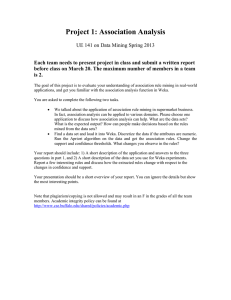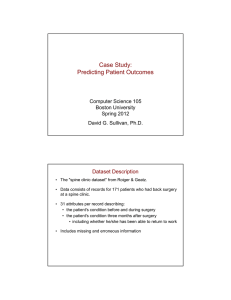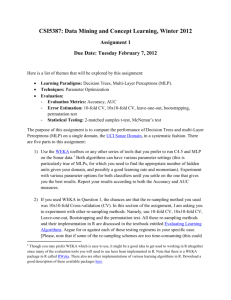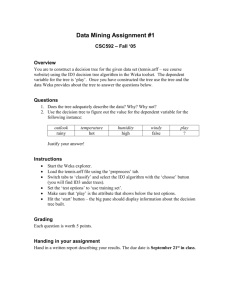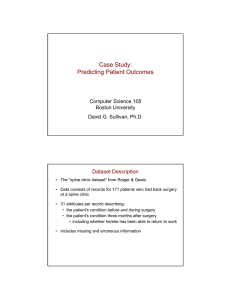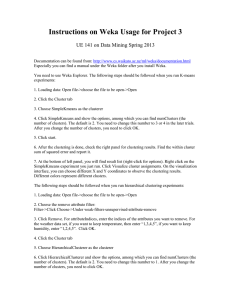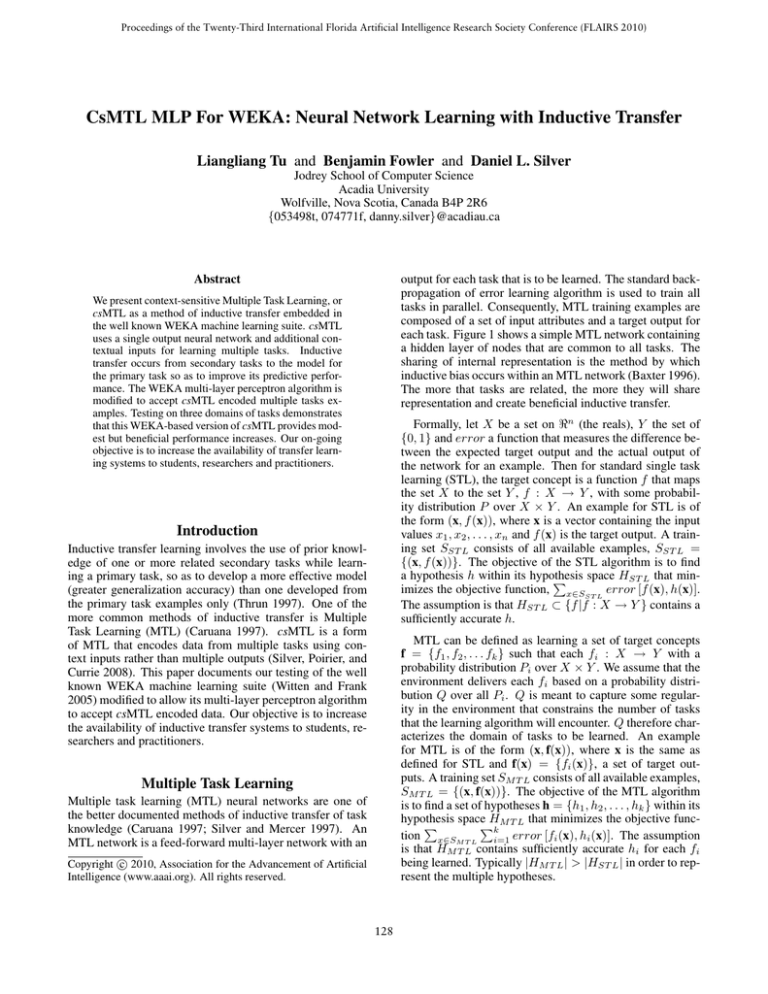
Proceedings of the Twenty-Third International Florida Artificial Intelligence Research Society Conference (FLAIRS 2010)
CsMTL MLP For WEKA: Neural Network Learning with Inductive Transfer
Liangliang Tu and Benjamin Fowler and Daniel L. Silver
Jodrey School of Computer Science
Acadia University
Wolfville, Nova Scotia, Canada B4P 2R6
{053498t, 074771f, danny.silver}@acadiau.ca
output for each task that is to be learned. The standard backpropagation of error learning algorithm is used to train all
tasks in parallel. Consequently, MTL training examples are
composed of a set of input attributes and a target output for
each task. Figure 1 shows a simple MTL network containing
a hidden layer of nodes that are common to all tasks. The
sharing of internal representation is the method by which
inductive bias occurs within an MTL network (Baxter 1996).
The more that tasks are related, the more they will share
representation and create beneficial inductive transfer.
Abstract
We present context-sensitive Multiple Task Learning, or
csMTL as a method of inductive transfer embedded in
the well known WEKA machine learning suite. csMTL
uses a single output neural network and additional contextual inputs for learning multiple tasks. Inductive
transfer occurs from secondary tasks to the model for
the primary task so as to improve its predictive performance. The WEKA multi-layer perceptron algorithm is
modified to accept csMTL encoded multiple tasks examples. Testing on three domains of tasks demonstrates
that this WEKA-based version of csMTL provides modest but beneficial performance increases. Our on-going
objective is to increase the availability of transfer learning systems to students, researchers and practitioners.
Formally, let X be a set on n (the reals), Y the set of
{0, 1} and error a function that measures the difference between the expected target output and the actual output of
the network for an example. Then for standard single task
learning (STL), the target concept is a function f that maps
the set X to the set Y , f : X → Y , with some probability distribution P over X × Y . An example for STL is of
the form (x, f (x)), where x is a vector containing the input
values x1 , x2 , . . . , xn and f (x) is the target output. A training set SST L consists of all available examples, SST L =
{(x, f (x))}. The objective of the STL algorithm is to find
a hypothesis h within its hypothesis
space HST L that min
imizes the objective function, x∈SST L error [f (x), h(x)].
The assumption is that HST L ⊂ {f |f : X → Y } contains a
sufficiently accurate h.
Introduction
Inductive transfer learning involves the use of prior knowledge of one or more related secondary tasks while learning a primary task, so as to develop a more effective model
(greater generalization accuracy) than one developed from
the primary task examples only (Thrun 1997). One of the
more common methods of inductive transfer is Multiple
Task Learning (MTL) (Caruana 1997). csMTL is a form
of MTL that encodes data from multiple tasks using context inputs rather than multiple outputs (Silver, Poirier, and
Currie 2008). This paper documents our testing of the well
known WEKA machine learning suite (Witten and Frank
2005) modified to allow its multi-layer perceptron algorithm
to accept csMTL encoded data. Our objective is to increase
the availability of inductive transfer systems to students, researchers and practitioners.
MTL can be defined as learning a set of target concepts
f = {f1 , f2 , . . . fk } such that each fi : X → Y with a
probability distribution Pi over X × Y . We assume that the
environment delivers each fi based on a probability distribution Q over all Pi . Q is meant to capture some regularity in the environment that constrains the number of tasks
that the learning algorithm will encounter. Q therefore characterizes the domain of tasks to be learned. An example
for MTL is of the form (x, f(x)), where x is the same as
defined for STL and f(x) = {fi (x)}, a set of target outputs. A training set SM T L consists of all available examples,
SM T L = {(x, f(x))}. The objective of the MTL algorithm
is to find a set of hypotheses h = {h1 , h2 , . . . , hk } within its
hypothesis space HM T L that minimizes the objective func
k
tion x∈SM T L i=1 error [fi (x), hi (x)]. The assumption
is that HM T L contains sufficiently accurate hi for each fi
being learned. Typically |HM T L | > |HST L | in order to represent the multiple hypotheses.
Multiple Task Learning
Multiple task learning (MTL) neural networks are one of
the better documented methods of inductive transfer of task
knowledge (Caruana 1997; Silver and Mercer 1997). An
MTL network is a feed-forward multi-layer network with an
c 2010, Association for the Advancement of Artificial
Copyright Intelligence (www.aaai.org). All rights reserved.
128
Figure 1: A multiple task learning (MTL) network with an
output node for each task being learned in parallel.
Figure 2: Proposed system: csMTL
In response to these problems, we have developed
context-sensitive MTL, or csMTL. csMTL is based on standard MTL with two major differences; only one output is
used for all tasks and additional inputs are used to indicate
the example context, such as the task to which it is associated. The following section describes the csMTL network.
Limitations of MTL for Lifelong Learning
Previously, (Silver and Mercer 2002; Silver and Poirier
2004; O’Quinn, Silver, and Poirier 2005) have investigated
the use of MTL networks as a basis for developing a machine lifelong learning (ML3) system and have found them
to have several limitations related to the multiple outputs of
the network1 . First and foremost, MTL requires that training examples contain corresponding target values for each
task; this is impractical for lifelong learning systems as examples of each task are acquired at different times and with
unique combinations of input values. We have examined
methods of generating corresponding target values but have
found weaknesses related to the differences in the distribution of examples over the input space for various tasks.
With MTL, shared representation is limited to the hidden
node layer and is not possible at the output nodes. The theory is that optimal inductive transfer occurs when related
tasks share the same hidden nodes. This perspective does not
consider the sharing of knowledge at the example level and
in the context of unrelated tasks. Consider two concept tasks
where half of the MTL training examples have identical target values. From a MTL task-level perspective, using most
statistical and information theoretic measures, these sets of
training examples would be considered unrelated and of little value to each other for inductive transfer.
There is also the practical problem of how a MTL based
lifelong learning agent would know to associate an example with a particular task. Clearly, the learning environment
should provide the contextual queues, however this suggests
additional inputs and not outputs. A related problem is managing the redundant representation that can develop for the
same task in an ML3 system based on MTL. A lifelong
learning system should be capable of practising a task and
improving its model with new examples over time. However, because there is no task context queue, an MTL based
ML3 system requires a separate output for each new set of
training examples. It is unclear how the build up of redundant task outputs could be managed over time.
csMTL
Figure 2 presents the csMTL network. It is a feed-forward
network architecture of input, hidden and output nodes that
uses the back-propagation of error training algorithm. The
csMTL network requires only one output node for learning
multiple concept tasks (more outputs could be used for predicting a vector of values for each task). Similar to standard
MTL neural networks, there is one or more layers of hidden
nodes that act as feature detectors. The input layer can be
divided into two parts: a set of primary input variables for
the tasks and a set of inputs that provide the network with
the context of each training example. The context inputs can
simply be a set of task identifiers that associate each training
example to a particular task. Alternatively, they can offer
more specific environmental information (such as latitude
and elevation) and in this way index over a continuous domain of tasks. Related work on context-sensitive machine
learning can be found in (Turney 1996).
Formally, let C be a set on n representing the context
of the primary inputs from X as described for MTL. Let c
be a particular instance of this set where c is a vector containing the values c1 , c2 , . . . , ck ; where ci = 1 indicates that
the example is associated with function fi . csMTL can be
defined as learning a target concept f : C × X → Y ; with a
probability distribution P on C × X × Y where P is constrained by the probability distributions P and Q discussed
in the previous section for MTL. An example for csMTL
takes the form (c, x, f (c, x)), where f (c, x) = fi (x) when
ci = 1 and fi (x) is the target output for task fi . A training set ScsM T L consists of all available examples for all
tasks, ScsM T L = {(c, x, f (c, x))}. The objective of the
csMTL algorithm is to find a hypothesis h within its hypothesis
space HcsM T L that minimizes the objective function, x∈ScsM T L error [f (c, x), h (c, x)]. The assumption
is that HcsM T L ⊂ {f |f : C × X → Y } contains a suffi-
1
ML3 systems are capable of learning a set of tasks over a lifetime such that early learning facilitates the learning of tasks later in
life.
129
ciently accurate h . Typically, |HcsM T L | = |HM T L | for the
same set of tasks because the number of additional context
inputs under csMTL matches the number of additional task
outputs under MTL.
With csMTL, the entire representation of the network is
used to develop hypotheses for all tasks, f (c, x), following the examples drawn according to P . The focus shifts
from learning a subset of shared representation for multiple tasks to learning a completely shared representation for
the same tasks. This presents a more continuous sense of
domain knowledge and the objective becomes that of learning internal representations that are helpful to predicting the
output of similar combinations of the primary and context
input values. Therefore, the important concept of relatedness shifts from the task level to the example level. During
learning, c selects an inductive bias over HcsM T L relative to
the secondary tasks being learned in the network. Once f is
learned, if x is held constant, then c indexes over the hypothesis base HcsM T L . If c is a vector of real-valued inputs and
from the environment, it provides a grounded sense of task
relatedness. If c is a set of task identifiers, it differentiates
between otherwise conflicting examples and selects internal
representation used by related tasks.
csMTL overcomes the limitations of standard MTL for
construction of a machine lifelong learning system (Silver,
Poirier, and Currie 2008). First, csMTL eliminates redundant outputs for the same task making it easier to accumulate knowledge of a task through practice. Secondly, csMTL
examples are associated directly with a task via the context
inputs, c. Finally, we conjecture that relatedness between
tasks can be measured by the similarity of the context c,
if c is environmentally grounded (such as the relative light
level).
validation set will start to increase. At the end of the training, but prior to testing the network model, the weights of
the neural network are returned to the point of the lowest
validation error. More specifically, the WEKA MLP uses
two parameters; validationSetSize and validationThreshold.
The validationSetSize parameter determines the percentage
of training set data use to create the validation set. The validationThreshold value is the number of iterations through
the training data without a reduction in validation error before training should be stopped. The MLP documentation
implies that the best set of weights will be restored after the
validationThreshold is met.
Upon inspection we discovered that the original WEKA
MLP software did not save the weights at the point of the
lowest validation error and therefore could not restore to
this model prior to testing. Instead, the weights used during testing were those of the last iteration completed. This
finding has important implications for researchers and practitioners using WEKA and the MLP algorithm, as it would
be very difficult to develop accurate neural network models under the current implementation. Furthermore, we discovered that the WEKA MLP software incorrectly changed
the value of the lowest validation error and saved the model
weights even when there had been a lower validation error
encountered earlier in training.
Having identified these problems, we took steps to correct
them. A modified version of the standard WEKA MLP was
provided to the WEKA development team and integrated
into new versions of WEKA. Now, the revised version of
WEKA corrects the MLP code so as to properly use the validation set as explained above.
Extensions to the WEKA MLP
Five extensions are designed and implemented for the original WEKA MLP.
WEKA and the csMTL MLP Algorithm
WEKA is an open source project of the University of
Waikato (Witten and Frank 2005). It has been widely used
in colleges and universities as well as by data mining practitioners on many real-world domains (McQueen et al. 1994).
The WEKA multi-layer perceptron (MLP) was implemented
by Malcolm Ware in 2000 (Ware 2000). Its use has been
documented in a number of research publications (Klautau
2002). Our challenge is to implement a new version of the
WEKA MLP such that it is capable of working with csMTL
encoded data.
Two important corrections and five extensions to the existing WEKA MLP are implemented in a new Java class,
MultilayerPerceptronCS (MLP CS). The following subsections will present each of these corrections and extensions. This modified code can be found on the web at
ml3.acadiau.ca.
-T Parameter The first extension is for the “-T
<filename>” parameter which allows the specification of
a data file containing training examples for one or more secondary tasks. The file type can be any normally accepted
by WEKA, which includes the comma separated values file
format (csv) and attribute-relation file format (arff). The secondary task data must contain the same number of input and
output values as the primary training data and in the same
order. Both the primary task and the secondary task data
files will contain all context and primary inputs, however
the secondary task data file will contain only secondary task
examples.
Duplication of Primary Task Training Examples The
second extension concerns the primary task examples which
normally are much fewer in number than that of each of the
secondary tasks. The primary task training examples are duplicated as many times as needed to ensure an equivalent
amount of training examples for each task. Without this duplication, the large number of examples for the secondary
tasks would overpower the training of the neural network
model such that the resulting model would perform poorly
for the primary task.
Correcting WEKA MLP Early Stopping
The WEKA MLP intends to employ an early stopping approach to prevent over-fitting by using a separate validation
set of data for the primary task. The network weights should
be saved each time a lower validation error is found. As the
model begins to over-fit to the training data, the error on the
130
Experimentation
-X Parameter The third extension is for the “-X
<filename>” parameter, which allows the specification of
a data file containing a separate set of validation examples
for the primary task. This allows greater flexibility than the
existing validation option, which selects a percentage of the
training set to act as a validation set. The existing validation
option is also modified to ensure that only primary examples
are used for the validation set in cross-validation mode.
It is important to note that, although training examples for
primary and secondary examples are used, only the accuracy
of primary task is considered as the performance indicator.
The model is developed to minimize the error on the validation data for the primary task and not across all tasks. A
sufficiently large number of training examples for secondary
examples are used so as to ensure the development of accurate models for these tasks without the need for early stopping via a validation set.
The following compares the predictive accuracy of learned
models developed under STL using only primary task examples with models developed under csMTL with inductive
transfer from secondary tasks. All models are developed
with our modified WEKA MLP CS. The objective is to develop models for the primary task from a small set of training examples so as to observe the effect of inductive transfer
from the secondary tasks.
Task Domains
Three domains are studied. The Band domain, described
in (Silver and Mercer 2002), consists of seven synthetic
tasks. Each task has a band of positive examples across a
2-dimensional input space. The tasks were synthesized so
that the primary task T0 would vary in its relatedness to the
other tasks based on the band orientation.
The Logic domain, described in (McCracken 2003) consists of six synthetic tasks. Each positive example is defined
by a logical combination of 4 of the 10 real-valued inputs of
the form, T0 : (I0 > 0.5∨I1 > 0.5)∧(I2 > 0.5∨I3 > 0.5).
The tasks of this domain are more or less related in that they
share zero, one or two features such as (I0 > 0.5∨I1 > 0.5)
with the other tasks. The Band and Logic domains have been
designed so that all tasks are non-linearly separable; each
task requires the use of at least two hidden nodes of a neural
network to form an accurate hypothesis.
The Covertype domain can be found at the UCI ML repository. The Covertype domain contains data from four wilderness areas in northern Colorado. Each example contains 10
input values representing information such as elevation and
soil type, and one output value that classifies the cover type,
that is, the species of tree that grows there. There are six
types of cover in the data, including various types of spruces,
firs, and pines. This is a large and noisy data set for which
previous methods have had a difficult time.
Table 1 shows the relevant statistics for each task domain
and for each cross-validation run: the number of tasks in the
domain, the number of primary input attributes, the number
of primary task training, validation, and test set examples,
and the number of training examples for each secondary
task. To clarify, the first row is for a cross-validation run
using 20 primary task examples and 200 secondary task examples for the Logic domain. The 20 primary task examples are used to complete a 10-fold cross-validation with 13
training, 5 validation and 2 test examples in each fold.
Cross-validation Statistics An additional feature added
for cross-validation is the reporting of the test set statistics
for each of the k models developed. This allows researchers
to compute the standard deviation over the models from the
repeated studies and therefore the confidence interval for
producing a model of the mean accuracy.
Additional GUI Components The fifth extension displays additional validation error information in the neural
network graphical user interface (GUI) while the system is
training. If the GUI is chosen, the resulting interface shows
not only the current iteration number and validation set error, but also the lowest validation set error and the iteration at
which it occurred. This addition facilitates error and model
monitoring as learning occurs.
Use of the New WEKA MLP CS Algorithm
The WEKA MLP CS algorithm has a number of modes of
operation that include the creation of a validation set, choice
of a specific test set, or alternatively cross-validation using
all available training data. Cross-validation was used for
all studies presented in this paper and below we explain the
changes made for this mode of operation. Additional details
can be found at ml3.acadiau.ca.
When testing inductive transfer methods, one normally
uses an impoverished set of data for the primary task so
as to demonstrate the value of knowledge transferred from
the secondary tasks. Our testing simulates this by providing
a small set of data for the primary task from which training, validation, and test instances are drawn. In comparison,
an abundance of examples are provided for the secondary
tasks. A 10-fold cross-validation is used to thoroughly test
the learning algorithm’s ability to develop accurate models.
For each cross-validation run, 10% of the primary task data
is used for testing. If the amount option for the validation set
is specified as 30%, then 30% of the remaining primary task
data is used for validation, and the rest is used for training.
In order to ensure the very best transfer of knowledge, 100%
of the secondary task data is used for training.
Method
STL and csMTL networks were configured using four-layers
of nodes. The input layer receives the primary and context
input values for each task. The first hidden layer contains 20
nodes with sigmoid transfer functions for the Logic domain
and 30 nodes for both the Band and the CoverType domains.
The second hidden layer contains only one sigmoid node.
This second hidden layer is necessary because it provides
shared internal representation between the first hidden layer
and output layer. Also, the networks were configured to generate nominal outputs; two possible class values. Therefore,
131
Table 1: Statistics for the three domains of tasks used in the experiment.
Tasks Input Attributes
Primary Task
Secondary Task
Train
Validation
Test
Training
Logic
6
10
13
5
2
200
10
16
7
2
200
10
19
8
3
200
10
25
11
4
200
10
32
13
5
200
10
63
27
10
200
10
126
54
20
200
Band
7
2
10
4
2
50
CoverType
6
10
28
12
4
300
Name
Figure 3: Comparison of STL and csMTL model performance across all domains.
the fourth output layer, contains two nodes, each representing a separate class. As an example, for the Logic domain,
we use a 16-20-1-2 network.
For each network, the learning rate is 0.001 and the momentum term is 0.9. All tests are run for 50,000 iterations.
The study compares the predictive accuracy over all examples using a 10-fold cross-validation approach.
It is important to note that, under csMTL, the number of
training examples for all tasks must be the same so as to ensure that each task has equal opportunity to update the network weights. This requires the primary task training examples to be duplicated until their number equals that of each
secondary task.
that the bar graphs above it present the mean results for the
Logic domain when only 20 examples were used for the
training, validation and test sets of data.
The respective p-values from a difference of means tTest betwen the STL and csMTL models are: Band domain,
0.716; Logic domain, 0.171; and CoverType, 0.036. The
results on the last two domains indicate that there is value
in using the csMTL over STL. This having been said, these
results are not as strong as that of prior studies using alternative MLP neural network implementations. The reasons for
this require further investigation.
Conclusion and Future Work
This paper has described context-sensitive MTL and modifications to the WEKA machine learning suite that allows its
MLP alogorithm to accept csMTL encoded data. This modification allows WEKA users to experiment with inductive
Results
Figure 3 shows the comparative results from the crossvalidation runs for the three domains. “Logic 20” indicates
132
transfer from related secondary tasks when faced with few
training examples for a primary task. Our intention is to increase the availability of inductive transfer machine learning
systems to students, researchers and practitioners.
The results of these initial experiments show that the
WEKA csMTL MLP algorithm is transferring knowledge
from secondary tasks to the primary task, but not at the same
level of performance as seen in prior studies using alternate
neural network implementations. We are investigating the
reason why the current implementation is not working as
well as anticipated.
In the future we intend to use the WEKA csMTL MLP to
explore new theory in inductive transfer and apply this theory to a variety of classification and predictive (real-valued)
tasks.
Ware, M. 2000. WEKA Documentation. University of Waikoto.
Witten, I. H., and Frank, E. 2005. Data Mining: Practical Machine
Learning Tools and Techniques. San Francisco: Morgan Kaufmann
Publishers, second edition.
Acknowledgments
This research has been funded in part by the Government of
Canada through NSERC.
References
Baxter, J. 1996. Learning model bias. In Touretzky, D. S.; Mozer,
M. C.; and Hasselmo, M. E., eds., Advances in Neural Information
Processing Systems, volume 8, 169–175. The MIT Press.
Caruana, R. A. 1997. Multitask learning. Machine Learning
28:41–75.
Klautau, A. 2002. Classification of peterson and barney’s vowels
using weka. Technical report, Universidade Federal do Par.
McCracken, P. 2003. Selective Representational Transfer Using
Stochastic Noise. Wolfville, NS, Canada: Honurs Thesis, Jodrey
School of Computer Science, Acadia University.
McQueen, R.; Neal, D.; DeWar, R.; Garner, S.; and NevillManning, C. 1994. The weka machine learning workbench : Its
application to a real world agricultural database. In Proc Canadian
Machine Learning Workshop.
O’Quinn, R.; Silver, D. L.; and Poirier, R. 2005. Continued
practice and consolidation of a learning task. In Proceedings of
the Meta-Learning Workshop, 22nd Int. Conference on Machine
Learning (ICML 2005).
Silver, D. L., and Mercer, R. E. 1997. The parallel transfer of
task knowledge using dynamic learning rates based on a measure
of relatedness. Learning to Learn 213–233.
Silver, D. L., and Mercer, R. E. 2002. The task rehearsal method
of life-long learning: Overcoming impoverished data. Advances in
Artificial Intelligence, 15th Conference of the Canadian Society for
Computational Studies of Intelligence (AI’2002) 90–101.
Silver, D. L., and Poirier, R. 2004. Sequential consolidation of
learned task knowledge. Lecture Notes in Artificial Intelligence,
17th Conference of the Canadian Society for Computational Studies of Intelligence (AI’2004) 217–232.
Silver, D. L.; Poirier, R.; and Currie, D. 2008. Inductive tranfser with context-sensitive neural networks. Machine Learning
73(3):313–336.
Thrun, S. 1997. Lifelong learning algorithms. Learning to Learn
181–209.1 Kluwer Academic Publisher.
Turney, P. D. 1996. The identification of context-sensitive features:
A formal definition of context for concept learning. In 13th International Conference on Machine Learning (ICML96), Workshop
on Learning in Context-Sensitive Domains, volume NRC 39222,
53–59.
133

